Our laboratory employs cutting-edge techniques and a multidisciplinary approach to determine the neural basis of addiction and why this varies across individuals.
Specifically, we are interested in how neuropeptides in the limbic system can act and interact to lead to alcohol use disorder (alcoholism) and binge eating disorder and how these actions may differ across individuals with the same disorder.
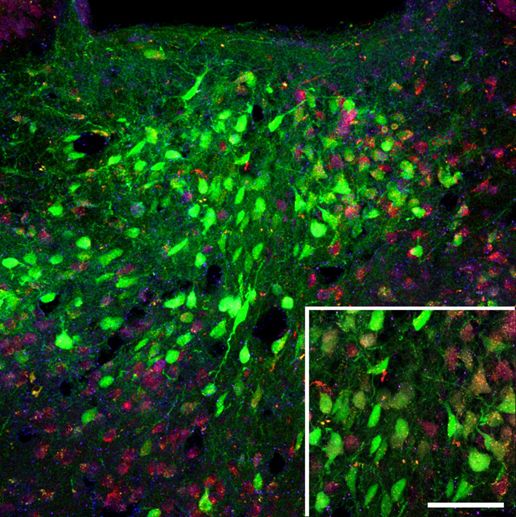
The PVT is a major node in the limbic system. Shown here is the PVT after injection with an adeno-associated virus (AAV) to express the neuropeptide, PACAP. Green = eGFP, red = PACAP-27 protein.
The paraventricular nucleus of the thalamus (PVT) functions as a major node in the limbic system, connecting homeostatic forces of the hypothalamus with non-homeostatic forces of other limbic nuclei such as the nucleus accumbens and prefrontal cortex, that act to promote reward-seeking.
Our laboratory is currently investigating how the PVT uses neuropeptides to communicate with other limbic brain regions to influence addictive behavior.
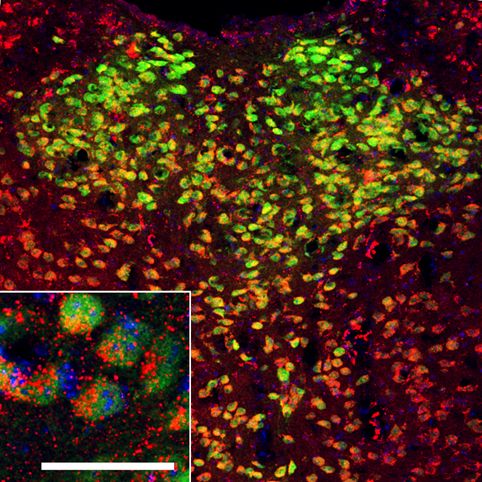
While the majority of cells in the paraventricular nucleus of the thalamus contain glutamate (seen here in green), there are also a number of different neuropeptides (shown here is PACAP-27, in red).
Neuropeptides are a class of neurochemicals that operate over a long time scale and are often transcribed in highly localized brain regions. This allows neuropeptides to affect very specific behaviors.
In studying addictive behavior, our laboratory focuses on how it is influenced by neuropeptides and how neuropeptides interact with each other and with classical neurotransmitters.
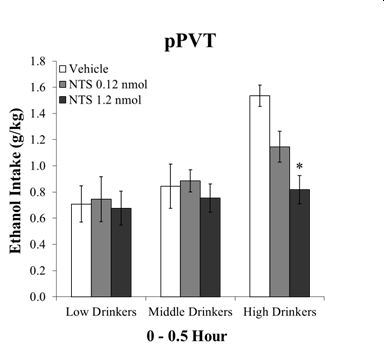
Injection of neurotensin (NTS) in the paraventricular thalamus reduces binge-like ethanol drinking in high drinking animals.
Current projects on alcohol use disorder (alcoholism) focus on how neuropeptides in subregions of the paraventricular thalamus as well as in the nucleus accumbens can affect binge drinking. Our goal is to discover innovative drug therapies to treat alcohol use disorder.
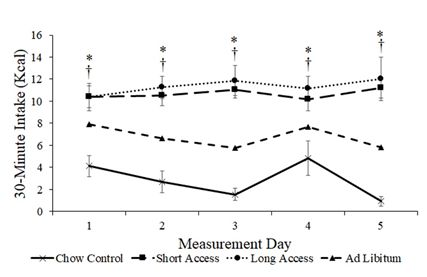
Limiting access to a palatable, sweet-fat food leads animals to consume significantly more calories than normal during a brief period.
Currently, the laboratory is examining how binge eating can be affected by neuropeptides in the paraventricular thalamus, nucleus accumbens and prefrontal cortex. By comparing these findings with those for alcohol drinking, we will be able to determine if systems controlling addictive behaviors are universal or if they are specific for the substance being consumed.
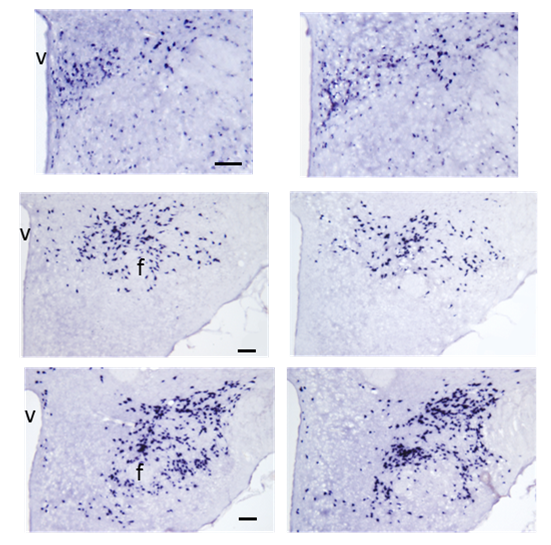
Individuals who drink excess alcohol due to their poor metabolism show different neuropeptide disturbances than those who drink due to their preference for novelty.
Alcohol use disorder (alcoholism) and binge eating disorder are heterogenous disorders in that individuals engage in these behaviors for a variety of reasons, both emotional and neurochemical.
We are currently investigating not just how neuropeptides can lead to bingeing on alcohol or palatable food, but how they may do this differently in different individuals. Our goal is for our research to inform precision medicine, to determine the best drug therapy for each individual.
The laboratory utilizes a wide variety of cutting-edge techniques to investigate the role of neuropeptides in addiction. These include:
- Chemogenetics (DREADDs), viral manipulation of gene expression
- Quantitative real-time PCR, in situ hybridization
- ELISA, Western blot, immunohistochemistry
- Tract tracing
- Microinjection in awake, behaving animals
- Operant substance self-administration and home cage intake
- Activity chamber locomotor behavior, open field locomotor behavior, hole board exploration, place preference, elevated plus maze anxiety, light-dark box anxiety, forced swim test
Back to Top